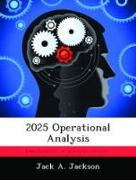2025 Operational Analysis
BücherAngebote / Angebote:
In the summer of 1995 the Air Force chief of staff tasked Air University to do a year-long study, 2025, to "generate ideas and concepts on the capabilities the United States will require to possess the dominant air and space forces in the future [, to] detail . . . new or high-leverage concepts for employing air and space power [, and to] detail . . . the technologies required to enable the capabilities envisioned." To support this goal a 2025 study team conducted an operational analysis to identify high-value system concepts and their enabling technologies in a way that was objective, traceable, and robust. This analysis determined which of the 2025 system concepts show the greatest potential for enhancing future air and space capabilities and which embedded technologies have the highest leverage in making the high-value system concepts a reality.The team developed a model, Foundations 2025, which reflected the overall values held by the 2025 participants. The purpose of the model was to quantify and compare different system concepts' contributions to future air and space capabilities. Foundations 2025 is distinguished by the large number of system concepts that can be analyzed, the 30-year focus into the future, and the fact it was developed through a bottoms-up approach. Foundations 2025 offers a potential new framework for future air and space doctrine that can be easily modified (broken into three separate models: awareness, reach, and power) by AF MAJCOMs for use in their mission area analysis process. Thus, the model presented is an aid to current and future senior decision makers concerned with the employment of air and space power. The 2025 study produced a number of excellent system concepts for employing air and space power in the future. Analysis of the highest-value system concepts indicated that the effort to occupy the "high ground" of the future will require air and space forces to possess increased awareness and to control the medium
Folgt in ca. 15 Arbeitstagen





